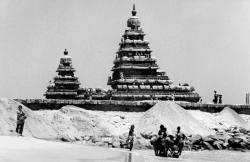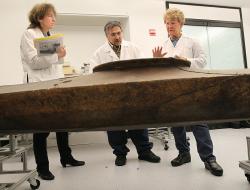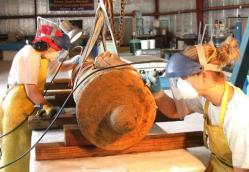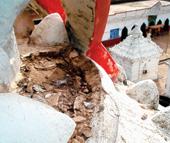INSTITUT SUPERIEUR D'ANTHROPOLOGIE
INSTITUTE OF ANTHROPOLOGY
ONLINE COURSES / COURS A DISTANCE
INSCRIPTION 2012 / Session II : Avril 2012
REGISTRATION 2012 / Term II : April 2012
INDE –  East Coast - For many, Kalki's Parthiban Kanavu may have been the inspiration to visit the remarkable coastal town of Mahabalipuram with its famous Shore Temple and monolithic Rathas. But, if visitors come looking for signs of the sleepy village that Narasimhavarman I, the great Pallava ruler of the seventh century transformed into a hub of artistic wealth, they will only find a tourist spot buzzing with people instead. Driving down the East Coast Road that connects Chennai to Mahabalipuram, a visitor is bound to encounter swanky vehicles travelling at great speeds to get to the destination within the hour. This quick connectivity has assured a steady surge of tourists from all over the world to this UNESCO World Heritage Site. Of the ASI protected monuments, however, the cluster at Mahabalipuram is probably still the most famous. Yet, along a road that was a used as an important route during the Chola period, several other monuments go largely unnoticed and their historical significance unappreciated. “The East Coast Road was known as ‘Vadagaperuvazhi', which is a route used during the Chola period to connect the kingdom to places in Thanjavur and Andhra Pradesh,” says Pradeep Chakravarthy, a Chennai-based historian. The historical ECR route, thus, begins from the gateway at the busy Thiruvanmiyur junction. “At the Marundeeswarar Temple, inscriptions can be found in the shrine of ‘Tripurasundari Amman' (Godess Parvati). These date back to the 11 century during the period of Rajendra Chola,” says historian Chithra Madhavan, who specialises in temple architecture. “Many of the Chola inscriptions are seen on the base of the north wall of the central shrine of the temple in Tiruvudandai . The inscription of the Rashtrakuta king Krishna III dated 959 A.D. is also on this wall,” she says. About a kilometre from Mahabalipuram in the village Vedal is the Vadavamukhagnishaarar Temple, which is very badly damaged, says Ms. Madhavan. Between Mahabalipuram and Puducherry, under the protection of the State Department of Archaeology, Government of Tamil Nadu are two monuments: The Vittal Temple in Vittalapuram and the Alamparai Fort in Kadapakkam. “The Vittal Temple has been conserved to the extent that it is now currently under worship,” says S.Vasanthi, Deputy Superintending Archaeologist at the Department. “We also excavated the Bhumisvara Temple at Marakkanam and discovered artefacts such as pottery and tiles from the Chola period,” she said about the excavation that took place in 2005-2006. “We are failing miserably in identifying places with historical significance and bringing it up as tourist spots,” says T.Satyamurthy, former superintending archaeologist, ASI who excavated the ruins of a Pallava Temple in Saluvankuppam after the 2004 Tsunami. “Many temples on the East Coast Road are 300 to 1,000 years old and they should be repaired without changing their characteristics”, he says “The government should take interest in protecting these monuments.”
East Coast - For many, Kalki's Parthiban Kanavu may have been the inspiration to visit the remarkable coastal town of Mahabalipuram with its famous Shore Temple and monolithic Rathas. But, if visitors come looking for signs of the sleepy village that Narasimhavarman I, the great Pallava ruler of the seventh century transformed into a hub of artistic wealth, they will only find a tourist spot buzzing with people instead. Driving down the East Coast Road that connects Chennai to Mahabalipuram, a visitor is bound to encounter swanky vehicles travelling at great speeds to get to the destination within the hour. This quick connectivity has assured a steady surge of tourists from all over the world to this UNESCO World Heritage Site. Of the ASI protected monuments, however, the cluster at Mahabalipuram is probably still the most famous. Yet, along a road that was a used as an important route during the Chola period, several other monuments go largely unnoticed and their historical significance unappreciated. “The East Coast Road was known as ‘Vadagaperuvazhi', which is a route used during the Chola period to connect the kingdom to places in Thanjavur and Andhra Pradesh,” says Pradeep Chakravarthy, a Chennai-based historian. The historical ECR route, thus, begins from the gateway at the busy Thiruvanmiyur junction. “At the Marundeeswarar Temple, inscriptions can be found in the shrine of ‘Tripurasundari Amman' (Godess Parvati). These date back to the 11 century during the period of Rajendra Chola,” says historian Chithra Madhavan, who specialises in temple architecture. “Many of the Chola inscriptions are seen on the base of the north wall of the central shrine of the temple in Tiruvudandai . The inscription of the Rashtrakuta king Krishna III dated 959 A.D. is also on this wall,” she says. About a kilometre from Mahabalipuram in the village Vedal is the Vadavamukhagnishaarar Temple, which is very badly damaged, says Ms. Madhavan. Between Mahabalipuram and Puducherry, under the protection of the State Department of Archaeology, Government of Tamil Nadu are two monuments: The Vittal Temple in Vittalapuram and the Alamparai Fort in Kadapakkam. “The Vittal Temple has been conserved to the extent that it is now currently under worship,” says S.Vasanthi, Deputy Superintending Archaeologist at the Department. “We also excavated the Bhumisvara Temple at Marakkanam and discovered artefacts such as pottery and tiles from the Chola period,” she said about the excavation that took place in 2005-2006. “We are failing miserably in identifying places with historical significance and bringing it up as tourist spots,” says T.Satyamurthy, former superintending archaeologist, ASI who excavated the ruins of a Pallava Temple in Saluvankuppam after the 2004 Tsunami. “Many temples on the East Coast Road are 300 to 1,000 years old and they should be repaired without changing their characteristics”, he says “The government should take interest in protecting these monuments.”
http://www.thehindu.com/news/cities/chennai/article2979123.ece
USA –  Alaska - The kayak rested on velour and foam pads, atop custom-made wheeled aluminum stands. Nearly a dozen people in white lab coats swarmed around it, taking notes on every seam and crack, photographing it inside and out with their iPhones and digital cameras. The 140-plus-year-old kayak is made of less high-tech stuff: at least five sea lion skins stretched over a wood frame, stitched together with sinew and wool and ornamented with human hair. Alutiiq warriors’ kayaks were normally buried with their owners, but this one was stored away at Harvard’s Peabody Museum of Archaeology and Ethnology for years and is now the focus of a months-long preservation project. For centuries, kayaks were central to the lives of the people of the southern Alaskan coast. “I heard a reference that to insult somebody, you said, ‘Your father had no kayak,’ ’’ Haakanson said with a laugh. Alutiiqs used their kayaks to hunt seals, whales, sea lions, and porpoise, for fishing, and for traveling through the Aleutians and, at least once, as far as San Francisco, he said. “It was critical. Without having those skills to go out and kayak, you were going to starve. You couldn’t survive in Kodiak without that knowledge.’’
Alaska - The kayak rested on velour and foam pads, atop custom-made wheeled aluminum stands. Nearly a dozen people in white lab coats swarmed around it, taking notes on every seam and crack, photographing it inside and out with their iPhones and digital cameras. The 140-plus-year-old kayak is made of less high-tech stuff: at least five sea lion skins stretched over a wood frame, stitched together with sinew and wool and ornamented with human hair. Alutiiq warriors’ kayaks were normally buried with their owners, but this one was stored away at Harvard’s Peabody Museum of Archaeology and Ethnology for years and is now the focus of a months-long preservation project. For centuries, kayaks were central to the lives of the people of the southern Alaskan coast. “I heard a reference that to insult somebody, you said, ‘Your father had no kayak,’ ’’ Haakanson said with a laugh. Alutiiqs used their kayaks to hunt seals, whales, sea lions, and porpoise, for fishing, and for traveling through the Aleutians and, at least once, as far as San Francisco, he said. “It was critical. Without having those skills to go out and kayak, you were going to starve. You couldn’t survive in Kodiak without that knowledge.’’
http://articles.boston.com/2012-03-10/metro/31140233_1_kayak-kodiak-lion
USA –  Greenville - Recovered artifacts from the Queen Anne’s Revenge, the sunken ship of famous pirate Blackbeard’s sunken ship, will be on display and open to the public next month. Items that will be part of the open house will include a 12 foot anchor and a ship’s cannon that is over eight feet long. The Queen Anne’s Revenge Conservation Lab at East Carolina University in Greenville will host an open house on Saturday, April 21st, from 11am to 3pm as underwater archaeologists will demonstrate the process of taking artifacts from ocean floor to museum door. Queen Anne’s Revenge is Blackbeard’s flagship that ran aground near Beaufort, North Carolina in 1718 and was abandoned by the pirate. Some have speculated that the fearsome and cunning pirate intentionally beached his ship to divide up the crew, giving him a larger share of any treasure. The discovery of the ship has been a major find in North Carolina and is viewed by many as one of the most intriguing under water archaeology discoveries on the eastern seaboard. Since 1997, the N.C. Department of Cultural Resources’ Underwater Archaeology Branch has led research at the shipwreck site and plans full recovery of the artifacts at the site by 2013. According to the branch, to date more than 280,000 artifacts have been recovered. At the open house, cannons, anchors, ballast stones, and other recovered artifacts housed at the lab will be presented in various stages of conservation.
Greenville - Recovered artifacts from the Queen Anne’s Revenge, the sunken ship of famous pirate Blackbeard’s sunken ship, will be on display and open to the public next month. Items that will be part of the open house will include a 12 foot anchor and a ship’s cannon that is over eight feet long. The Queen Anne’s Revenge Conservation Lab at East Carolina University in Greenville will host an open house on Saturday, April 21st, from 11am to 3pm as underwater archaeologists will demonstrate the process of taking artifacts from ocean floor to museum door. Queen Anne’s Revenge is Blackbeard’s flagship that ran aground near Beaufort, North Carolina in 1718 and was abandoned by the pirate. Some have speculated that the fearsome and cunning pirate intentionally beached his ship to divide up the crew, giving him a larger share of any treasure. The discovery of the ship has been a major find in North Carolina and is viewed by many as one of the most intriguing under water archaeology discoveries on the eastern seaboard. Since 1997, the N.C. Department of Cultural Resources’ Underwater Archaeology Branch has led research at the shipwreck site and plans full recovery of the artifacts at the site by 2013. According to the branch, to date more than 280,000 artifacts have been recovered. At the open house, cannons, anchors, ballast stones, and other recovered artifacts housed at the lab will be presented in various stages of conservation.
http://raleightelegram.com/201203111102
INDE –  Odisha - The 300-year-old Baldevjew temple, built in 1707 when the Marathas ruled this region, is crumbling. While the state archaeology department pleads helplessness, citing fund crunch for the conservation work, servitors and devotees dismiss this as a lame excuse. The dadhi nauti (summit structure) of the medieval temple had developed a major crack about a year-and-half ago. A month later, some portions of its bhog ghar (Lord’s kitchen) caved in. “The temple is a four-way structure and devoid of architectural design. The Maratha style of temple-building was mostly simple without intricate stone carvings,” said Bijay Kumar Rath, archaeologist and former superintendent of the department. “It seems the medieval period structure is bearing the brunt of vagaries of nature. It requires instant conservation work,” he said.
Odisha - The 300-year-old Baldevjew temple, built in 1707 when the Marathas ruled this region, is crumbling. While the state archaeology department pleads helplessness, citing fund crunch for the conservation work, servitors and devotees dismiss this as a lame excuse. The dadhi nauti (summit structure) of the medieval temple had developed a major crack about a year-and-half ago. A month later, some portions of its bhog ghar (Lord’s kitchen) caved in. “The temple is a four-way structure and devoid of architectural design. The Maratha style of temple-building was mostly simple without intricate stone carvings,” said Bijay Kumar Rath, archaeologist and former superintendent of the department. “It seems the medieval period structure is bearing the brunt of vagaries of nature. It requires instant conservation work,” he said.
http://www.telegraphindia.com/1120222/jsp/odisha/story_15155450.jsp
INDE – Kancheepuram - Rapid urbanisation in Kancheepuram district coupled with ignorance of the local people is a real threat to valuable megalithic sites. Objects like stone circles, dolmens, stone mounds or Cairn on the surface level hold the key to identification of megalithic burial sites. If these symbols are damaged, disrupted or removed, it could prove to be impossible to identify an Iron Age burial site. Speaking to Express, Sathyabama Badrinath, Superintending Archaeologist, ASI, Chennai Circle said if surface indicators like stone circles were damaged or construction of buildings happened in the area, it could permanently preempt the opportunity for identification and later excavation of burial sites.
http://ibnlive.in.com/news/rapid-urbanisation-is-the-biggest-worry/238303-60-118.html
PAKISTAN – Ranigat - A team of Japanese experts has completed the conservation work on sites of Gandhara particularly Ranigat as important part of their project and handed over the sites to Department of Archaeology and Museums. Prof Koji Nishikawa, archaeology expert from Japan and his team also compiled a comprehensive report “Scientific Expedition to Gandhara Ranigat; A Buddhist site in Pakistan” which took 27 years to complete. The project of UNESCO Japan Funds-in-Trust primarily focused on Preservation of Gandhara Monuments with main site of Ranigat with other sites of Butkara, Thareli, Sahr-i-Bahlol, Takht-i-Bahi, Chanaka-Dheri, Mekhasanda, Taxila and Manikyala.
http://www.thenews.com.pk/Todays-News-13-13095-Japanese-experts-complete-conservation-work
FRANCE -  Paris - Celebrating the flourishing era of Islamic culture, the Louvre museum prepares to unveil a new wing for Arts of Islam. Preparing to open to the public this summer, the new wing will exhibit more than 18,000 artworks from the Arab world and Europe, some for the first time. The collections will be displayed over an area of roughly 3,500 square metres, subdivided into only two levels. The first floor, at courtyard level, will house works from the seventh to the 10th centuries. The second, in the basement will exhibit works from the 11th to the 19th centuries along with a prestigious collection of carpets. The wide variety of exhibited items ranged from gorgeous selection of metalware from Syria, Ottoman ceramic tiles, the Mamluk emirs possessions and masterworks from Andalusia. “The Louvre has, for example, the best collection in the world of luxury inlaid metalware made in Syria during the 13th century, the Ayyubid period, and owns the most famous basin ever made during the Mamluk era (1250-1517), the so-called Baptistère de Saint Louis, from the royal collections,” Sophie Makariou, head of the Islamic arts department, told The National. Working on the artifacts since 2006, 2,000 Ottoman ceramic tiles were removed from their frames to be fully restored and an entire collection of Egyptian stained-glass windows was subjected to a scientific and technical study, indispensable for their upkeep. “We have also masterworks originating in Andalusia and some tombstones from Arabia,” added Makariou, referring to a famous ivory box: the Pyxis of Al-Mughira, from the year 968. Yet, some items remained ambiguous with no certain purpose known for its usage. “The archaeology of the Islamic period is a peculiar one … There is no funerary archaeology, which means that most objects were found, very often broken, in the setting where they were used,” she said. “Very often, as there were a lot of purely commercial diggings, the relevant information provided by a proper excavation was lost. “The most precious objects of the past, metalwares or manuscripts, were preserved through collectors, whom history has not yet traced back as far as the Islamic realm,” said Makariou.
Paris - Celebrating the flourishing era of Islamic culture, the Louvre museum prepares to unveil a new wing for Arts of Islam. Preparing to open to the public this summer, the new wing will exhibit more than 18,000 artworks from the Arab world and Europe, some for the first time. The collections will be displayed over an area of roughly 3,500 square metres, subdivided into only two levels. The first floor, at courtyard level, will house works from the seventh to the 10th centuries. The second, in the basement will exhibit works from the 11th to the 19th centuries along with a prestigious collection of carpets. The wide variety of exhibited items ranged from gorgeous selection of metalware from Syria, Ottoman ceramic tiles, the Mamluk emirs possessions and masterworks from Andalusia. “The Louvre has, for example, the best collection in the world of luxury inlaid metalware made in Syria during the 13th century, the Ayyubid period, and owns the most famous basin ever made during the Mamluk era (1250-1517), the so-called Baptistère de Saint Louis, from the royal collections,” Sophie Makariou, head of the Islamic arts department, told The National. Working on the artifacts since 2006, 2,000 Ottoman ceramic tiles were removed from their frames to be fully restored and an entire collection of Egyptian stained-glass windows was subjected to a scientific and technical study, indispensable for their upkeep. “We have also masterworks originating in Andalusia and some tombstones from Arabia,” added Makariou, referring to a famous ivory box: the Pyxis of Al-Mughira, from the year 968. Yet, some items remained ambiguous with no certain purpose known for its usage. “The archaeology of the Islamic period is a peculiar one … There is no funerary archaeology, which means that most objects were found, very often broken, in the setting where they were used,” she said. “Very often, as there were a lot of purely commercial diggings, the relevant information provided by a proper excavation was lost. “The most precious objects of the past, metalwares or manuscripts, were preserved through collectors, whom history has not yet traced back as far as the Islamic realm,” said Makariou.
http://iina.me/wp_en/?p=1007243